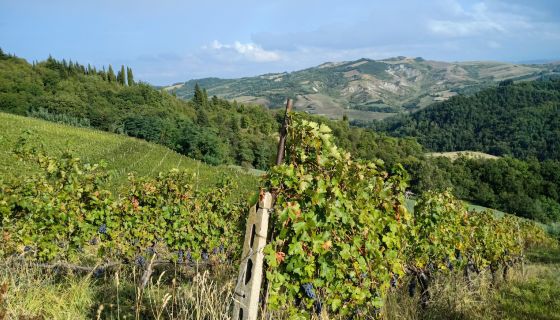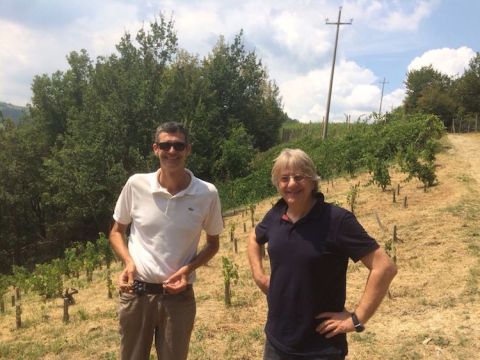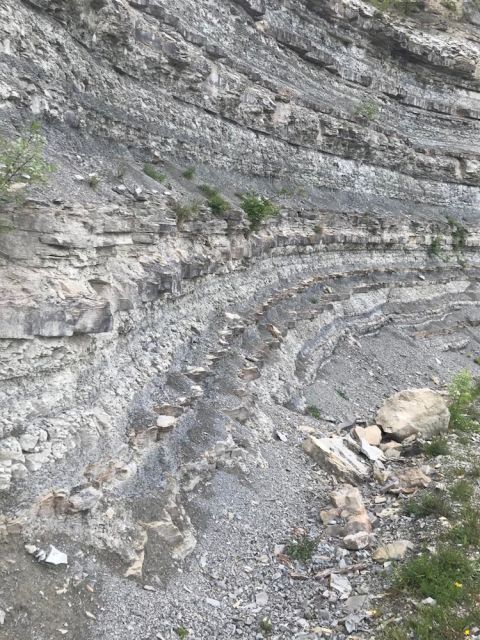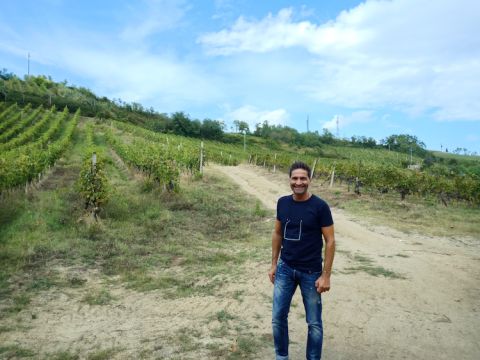26 August 2020 Sangiovese, apparently attached by an umbilical cord to Tuscany, has an equally fascinating and long history in Romagna, where it has been cultivated for at least 400 years. After years of neglect, Romagna is finally returning to its glorious past. To accompany this article, Walter's tasting notes on some superior Romagna Sangiovese are also published today.
One of the most radical changes I have witnessed in the last couple of years in Italy is the qualitative turnaround of Romagna Sangiovese – and not just in terms of nomenclature. Once called Sangiovese di Romagna on labels, this huge denomination changed its name to Romagna Sangiovese around 2011 in a move more symbolic than truthful. I considered it an empty gesture designed to direct attention away from the variety and towards origin at a time when most wines produced here didn’t seem to me to truthfully express either one.
There were exceptions, such as the wines of a Romagna stalwart like Cristina Geminiani at La Zerbina. She has been bent on quality as well as the denomination from the moment she replanted all of her vineyards as bush vines (Romagna's historic training system ad alberello). Recently a small group of producers in the hills of Forlì, on the cusp of the Apennines that separate Romagna from Tuscany, has also attracted attention with a spectacular line-up of wines, all based exclusively on Sangiovese. Ten of them, from the town of Modigliana, have banded together in a private association called Stella dell'Appennino Modigliana, which, due to the high quality of their output, immediately caught the attention of the Italian wine media.
The masterminds behind the association are wine journalist-turned-garagiste wine producer Giorgio Melandri and agronomist Francesco Bordini (pictured below), leading the group on what will prove to be an unstoppable track towards international success due to the highly original wines they produce from 100% Sangiovese in high-elevation vineyards here. History shows that these wines didn't come out of the blue, but connect to a distant past.
The historic tussle between Tuscany and Romagna about the origins of the Sangiovese that is widely planted in both regions was solved to the advantage of Tuscany, when recent DNA research revealed it is a cross between Calabrese di Monenuovo, an obscure variety from the south, and Tuscany's Ciliegiolo. But even before this discovery, Tuscany claimed the Sangiovese crown, while Romagna’s Sangiovese was generally mediocre.
To understand Romagna and its enormous potential one needs to stop looking at it as a Sangiovese also-ran, a kind of cheap alternative to the real thing – Tuscany. This view, in combination with some pretty ordinary wines at low prices in the past, which eroded Romagna's reputation, became a huge obstacle for much-needed investment that could trigger change.
The sharp contrast between the two regions, qualitatively speaking, resulted in a bias against Romagna, which recent historical research, neatly compiled by Beppe Sangiorgio and Giordano Zinzani in their book, Sangiovese – Vino di Romagna*, tries to rectify.
Geographically the two regions differ in exposure, with vineyards on the Tuscan side generally facing south-west and vineyards on the Romagna slopes facing north-east and generally at higher elevations, between 450 and 600 m (1,500 to 2,000 ft) in the case of Modigliana and the nearby village of Predappio Alto. Historically, the prevalent training system in Tuscany was vite maritate ad alberi, where vines climbed up on trees, while in Romagna the classic training method used to be high-density bush vines in an effort to increase yields on the very poor marl and sandstone soils – a monoculture of vines rather than mixed agricultural crops in one plot. To this day, alberello vineyards of bush vines such as those shown below, several on their own rootstocks, can still be found in Modigliana.
The first mention of Sangiovese in 1597 is in Tuscany, where, in a treatise on viticulture, it is mentioned as 'Sangiogheto'. In 1672 Sangiovese is mentioned for the first time in Romagna in a notarial act, in which the owner of Podere Fontanella in Casola Valsenio in the Faenza Apennines rents out 'tre filari di Sangiovese' (three rows of Sangiovese) to Don Piancastelli, the parish dean of Pagnano, a stone's throw away and also in the Senio Valley. This 1672 document also describes Sangiovese as a robust, adaptable variety, the Podere Fontanella being at an elevation well over 400 m (1,300 ft) on a north-west-facing slope. Several documents from the late 19th century praise Sangiovese from the higher parts of Romagna for their quality, remarking on their fine aromas together with the fact that they were completely dry.
From the earliest documented history, the mountainous part of Romagna, rather than today's plains, have been the nucleus of wine quality, only to be watered down at the end of the 19th century when downy and powdery mildew and then phylloxera were imported from America. In fact, this helped to advance Sangiovese's cultivation in large parts of Italy because it seemed to resist these diseases marginally better than other varieties, while new clones producing high yields were encouraged in order to recoup losses and to fire-up local economic engines once it had been discovered that grafting on to phylloxera-resistant rootstocks permitted viticulture once more.
Not all viticulturists agree on Sangiovese's superior resistance but the variety did emerge relatively unscathed by these three American imports, especially in Modigliana and neighbouring Predappio Alto. In these mountainous and isolated parts of Romagna, some vineyards are surrounded by dense forests, which may have provided some sort of barrier.
In a text published in the tasting booklet of the 2019 presentation of the Modigliana wines** Melandri explains that without wine the local peasant population would not have had enough calories to survive. Wine was an indispensable nourishment, and therefore vines were planted even at high, marginal altitudes in forest clearings where no other crops would have survived. Only in the 20th century did vineyards become more common on the flat, much easier-to-work, fertile clay soils of the plains. The hillside vineyards were eventually abandoned in favour of the Adriatic coast.
Rock and earth
In the same booklet Bordini describes the main soil compositions in the Romagna hills: marna or marl, a calcareous rock, and arenaria or sandstone. Both are sedimentary rocks formed millions of years ago through the calcification of sand (le arenarie) and clay (argilla).
According to Bordini, the lower hills and the plains of Romagna, mainly consisting of clay, are separated by a neat line from the marl and sandstone in the higher parts of the Apennines towards the border of Tuscany. According to Bordini this line forms a clear border between two completely different stylistic worlds which Sangiovese, il grande lettore di territori, or great reader of terroir as he calls it, translates perfectly: lots of fruit and rich, soft tannins on clay; and austere, saline and elegant wines on sandstone and marl.
Bordini points out that the wide variety of soils in these hills, based on a mix of both marl and sandstone, are made more complex by organic matter from the surrounding forests and minerals from the weathered rock content.
Bordini calls the soils the 'children of rocks, forests, vines and time'. These poor soils, often on steep slopes, difficult to cultivate, not least because the forests continuously try to reconquer the vineyard land. According to Bordini the forest and vegetation surrounding the vineyards are essential, and must remain untouched in order to continue their interaction. This is a concept now gaining traction in Italy, with many producers now deciding to keep the forests and shrubs surrounding the vineyards intact or looking for patches of vineyard near forests.
The forests form a natural barrier to pollution, help mitigate the vagaries of climate change, and regulate humidity and temperature, while also having water-retaining capacities. At the same time they safeguard biodiversity by counterbalancing the monoculture of vine cultivation, and are home to natural organisms that are predators to parasites that can threaten the vines. Historically, these Romagna vineyards in the forests were known as Ronchi, from roncare, to cut wood.
Romagna's decline – and resurrection
From the early 1960s onwards, owing to the large volumes of low-quality wines made from grapes grown in the plains and vinified in the huge tanks of undiscerning co-ops, Romagna Sangiovese's reputation started to fade. At the same time, from the 1980s onwards a notable rise in quality in Tuscan wines started to overshadow whatever fame Romagna Sangiovese still had.
The new-wave wines now made in Modigliana find their inspiration in its distant past. In the 1970s, at a time when no-one searching for wine potential was looking at Romagna, film director Gian Vittorio Baldi, a native of Lugo in the province of Ravenna, began looking around Modigliana for a place to make wine.
Attracted by its natural beauty, but unaware of the historic value of its terroir, he founded Castelluccio. One day, his friend, the legendary wine critic Luigi Veronelli, during a visit to the estate, recommended he should vinify each plot separately. This was how, around 1980, and with help from Tuscan oenologist Vittorio Fiore, the single-vineyard 'Ronchi' came to be, referencing the historic vineyards conquered from the forest here. Castelluccio's steep vineyards were initially ridiculed by conventional producers, but soon Castelluccio became a beacon for the whole of Romagna. Fiore became so convinced of Modigliana's stellar qualities that he decided to buy a major share in Castelluccio in the 1990s.
From that moment on, Fiore identified and started to produce not one but three single crus, Ronco delle Ginestre, Ronco del Re and Ronco dei Ciliegi. I still remember, years ago, while having dinner in Da Buriani, a restaurant 30 km (19 miles) north of Bologna, the sommelier suggesting the 1986 Ronco delle Ginestre. Initially I was hesitant, not really interested in a Sangiovese from Romagna, but the wine, elegant, long and complex, made me realise how little I knew of Romagna's hidden treasures. Castelluccio is now run by Fiore's son Claudio, who together with his wife Veruska Eluci in 1999 stumbled across Balìa di Zola, a farm founded in 1700, where from the mid 2000s they also began producing wines. Both estates are associates of the Modigliana producers' group.
In 2011 the Romagna subzones, 12 in total, where drawn up in a laudable effort to better reflect regional differences within this large region. These subzones have begun to appear on labels, but several producers refuse to use them because they do not agree with how the boundaries have been drawn. Nicolucci in Predappio Alto at 450 m and not far from Modigliana is one of them. The estate has been making wine at least since the end of the 19th century with a very few bottles left as proof. When official plans for the subzone Predappio were drawn up, it turned out that the area would not be limited to the intersection of three ridges that form the small Predappio Valley with vineyards historically situated on its flanks, but ran all the way up to Forlì including large swathes of the plain.
Being the only one left producing any wine at all in Predappio at that time, in protest Nicolucci pulled out of the project they were asked to participate in. The plans went ahead anyway, in order to accommodate the co-ops, which receive large quantities of grapes grown on these plains but are unable to produce wines of real distinction.
Stylistically, too, Nicolucci faced problems that had a real economic impact on the estate. ‘We had problems selling our wine when barriques were all the rage’, I was told by Nicolucci's son Alessandro who now runs the estate. Instead, their Sangiovese has always been aged in large oak casks of Slavonian and Italian oak and chestnut. In the past, cheap chestnut was widely used by cash-strapped producers. In cooler vintages, the chestnut casks usefully added a brownish red colour and additional tannins when, at these elevations, Sangiovese would develop little colour in the skins.
Nicolucci compares Romagna with Cinderella because, unlike Tuscany, it lacked nobility such as Baron Ricasoli of Chianti Classico residing in the countryside and pushing for high quality. Instead, from the beginning of the 20th century, the region became dominated by large co-ops incentivising volume rather than quality. In contrast to this, the vineyards of Predappio Alto had always been planted with low-yielding bush vines at the staggering density of 10,000 vines/ha.
But, as in Modigliana, there is significant change in these hills. The youthful Chiara Condello, for example, is the most recent arrival, taking Predappio Alto as her lead, something made easier by the historic Nicolucci estate as a blueprint and inspiration and the staunch defender of a transparent, vibrant style of wines produced for more than 100 years. Cinderella is about to wake up.
Developments such as these resonate in other subzones too and are about to radically change the perception of Romagna Sangiovese as a whole. In the subzone of Brisighella, Cesare Gallegati makes an entry-level Romagna Brisighella Sangiovese Corallo Rosso that defies its category and low price (it’s sold for around €10 a bottle in local enotecas). Typified by tangy red fruit with a savoury edge and delicious chewy tannins, this wine seems light and yet is not.
When I suggested to Gallegati that he should increase the price be more in line with its intrinsic quality, Lorenzo Rondinelli, his agent for Italy, who also represents the likes of Gaja and who once worked at The Ritz in London and the Trussardi Alla Scala restaurant in Milan, was quick to protest. According to him, a higher price for this Romagna Sangiovese – which, unsurprisingly, sells like hot cakes – would have a negative impact on sales.
Gallegati vinifies 9,000 bottles of Sangiovese (the balance being 6,000 bottles of ageworthy Romagna Trebbiano, as witnessed by a 1999 vintage he poured me … but that is another story altogether) from 6 ha (15 acres) of vineyard on red clay soils at 250 m (820 ft) and are all labelled with the suffix Brisighella. He does this because the regulations for the subzone are stricter than for generic Romagna Sangiovese. For one, the wine must contain at least 90% Sangiovese (the balance being practically whatever you like), and residual sweetness is not allowed. I was shocked to hear that in generic Romagna Sangiovese up to10 g/l residual sugar is pretty much the norm. This surely demonstrates the qualitative weakness of co-op wines and suggests that they, and the local lawmakers, have little interest in improving quality.
Ironically, the Modigliana grass-roots movement was triggered by a discovery Melandri made at Agrintesa, a co-op in Modigliana of all places. Grapes delivered to the co-op come from three different valleys, all with their own macro-climate and, crucially, picked at different times. They therefore have to be vinified separately according to the day the grapes were delivered.
While tasting the various tanks, Melandri began to identify stylistic differences even in an area as small as Modigliana. This, in turn, triggered the idea of making three different wines, reflecting the character of the three valleys. He founded the micro-estate Mutiliana with the help of agronomist and oenological consultant Francesco Bordini. The couple then persuaded ten producers to band together in an effort to change the fortunes and reputation of Romagna Sangiovese, and in doing so they have produced something that really shines out in a sea of mediocrity: wines that truly reflect their unique subzone.
The co-ops are not entirely able to ignore this development, fortunately. Melandri’s wife Elena Piva is communications and project development manager at Le Rocche Malastiane co-op at the other end of the spectrum from her husband, and knows this from personal experience. Corralling 500 grape producers from the Colli di Rimini, a separate region producing Sangiovese, the co-op has been trialling a system in which grapes from different zones within the denomination are vinified separately in order to establish their stylistic characteristics based on origin.
Trying to get the co-operation of other estates within the denomination for this project is an uphill battle because, in general, co-ops are seen as counterproductive in striving to achieve higher quality and higher prices and are compromised by their low reputation. But the project is valuable, because it is a recognition of the peculiarities of the different terroirs while making those the basis for different wines. Any initiative working towards this goal deserves support because it takes steps in improving the image and the wines from Romagna starting from the very base. The region will be better for it.
References
*B Sangiorgi, G Zinzani, Sangiovese – Vino di Romagna. Valfrido Edizioni, 2015.
**Catalogue Stella dell'Appennino Modigliana, Edizione 2019.


















